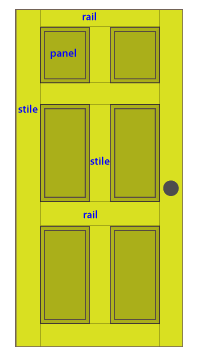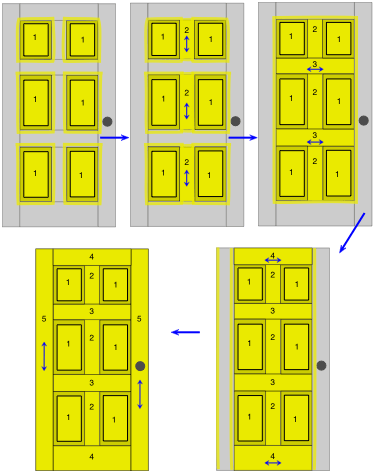How to Paint Interior Doors
by: Dale Cox
This page describes techniques for painting interior doors and includes methods for applying a smooth, even coat to both raised-panel and flat surface doors.

Doors between the rooms of a house are usually either a plain, flat surface or there can be one or more raised panels dividing the face into square or rectangle shapes. Flat doors are easy to paint without leaving brush marks but raised panels in MDF, or actual floating panels in solid wood doors can be hard to paint without leaving brush and drag marks in the finish. These unsightly marks occur when the brush touches partially dry paint as you try to get an even coat over the various contours of the surface. The trick is to paint the different parts of a raised-panel door, one at a time, and then blend each section seamlessly with its neighbor.
The parts of a raised-panel door are pictured here and include: the rails, stiles, and panels. The rails are the cross members and include the top and bottom as well as the cross pieces dividing the middle. The stiles are the pieces that run vertically and include the small pieces between the panels and the two long pieces on each side. The side stiles run from the top to the bottom of the door and tie the rails, the center stiles, and the panels together.
The panels are the inset squares or rectangles. Most newer homes with raised-panel doors are the imitation kind where the impression of a panel is pressed into MDF. In an old house with wood doors or a new house with high-end solid wood doors, the panels are separate pieces of wood that fit into a groove cut along the edges of the rails and stiles. These panels are designed to float in the frame as the wood expands and contracts with the moisture and temperature changes in the surrounding atmosphere.
Over time, movement in the floating panels can cause the paint film to crack around the border. Many people make the mistake of caulking these cracks to hide them. The problem with caulking around a raised panel is it only creates a more unsightly caulk cracking problem. The best way to deal with cracking paint around a raised panel is to fill it with more paint, not caulk. If you have cracking caulk around the panels in your raised-panel door, you should scrape it off completely, sand it down to smooth wood, and then repaint, giving extra attention to the panel borders to fill them well with paint.
Preparation to Paint a Door
Remove the handles to make sanding and painting easier. Prep a previously painted surface by sanding with 120 or 220 grit sandpaper. Use 120 for sanding oil-based paint and 220 for bare wood and latex paint. Start at the top and sand each segment of the door, one at a time. If you're repainting over latex paint, sand very lightly with 220 paper. Being too rough with the surface will cause the old paint to tear and curl up, not sand off. You just want to lightly scuff up the shine on the old paint to prepare it for a new coat. Remove the sanding dust using a vacuum cleaner and/or tack cloth before applying the finish paint. This is particularly important when using an oil or high-gloss paint because these finishes tend to show any remnants of dust in the surface.
If you're dealing bare wood, sand it well with 220 sandpaper and follow with two coats of primer. For the most durable finish, prime with an oil or alkyd-based under coater instead of latex. Let it dry for 12 to 24 hours between coats. If your new paint will be a very dark color, tint the primer to more closely match the finish before applying it to make coverage easier. After the primer is completely dry, lightly sand with 220 paper and remove the sanding dust.
Painting a Raised-Panel Door
Doors and windows in a house are usually done with an enamel finish paint. Enamels are available in both latex and oil-based formulas and come in shiny finishes like semi-gloss and high-gloss. Because it dries to a hard, durable finish, enamel paint provides lasting protection for door surfaces that tend to see a lot of wear and tear. And because it is so durable, enamel can be washed to remove marks and dirt to maintain the shine and beauty of the finish for years to come.
Start at the top when painting raised-panel doors and paint all of each part before moving to the next part. Paint all the panels first, then paint the inner rails and small inner stiles. Next, paint the top and bottom rails and finish by painting the edges and the long outer stiles. Work quickly to finish each part so the paint doesn't set up before you can do the adjoining parts.
If you're only painting one side of a door, paint the edge that shows from that side when it's open. For example, if you're painting the outside of a door that opens into a room, paint the edge where the hinges show when it's open. Conversely, if you're painting the inside, paint the edge where the latch plunger is visible when the door is open.
Painting the Panels

Starting at the top and paint the raised panels. Push the paint into the corners and cracks around the panel border letting it overlap a bit onto the surrounding rails, stiles, and the center of the panel itself. Brush the paint out along all four edges to smooth it and remove any excess that pools along the bottom.
Next, paint the center of the panel applying the paint with back and forth horizontal strokes to cover it completely with a thick coat. Then stroke vertically up and down the panel with a semi-dry brush to smooth out the coat and remove the excess paint. Finish by brushing along all four edges of the border again a few times with a semi-dry brush to smooth and pick up any remaining excess paint. Runs will develop at the bottom corners of the panels if all the excess paint is not removed.
Painting the Rails and Stiles

With the panels done, go back to the top and start painting the short, center stiles and inner rails between the panels. Blend these two parts together by painting the short stile first with vertical strokes letting the paint overlap the rails a bit. Next paint the inner rails with horizontal strokes letting the paint overlap the side stiles a bit.
As you paint these inner parts, smooth out the lap marks from the adjacent parts. On the inner stiles, smooth out the lap marks from the panels. On the inner rails, smooth out the lap marks from the panels and the short stiles.
Move down the door painting these interior pieces until all the inner rails and small inner stiles are done. Next paint the top and bottom rails letting the paint overlap onto the side stiles a bit. Finish by returning to the top to paint the edge and down the two side stiles. Smooth all the lap marks from the rails, panels, and edge with the vertical strokes along the outer stiles.
Painting Flat Doors

Flat, hollow-core doors are commonly found in newer houses and can be made of wood, MDF or plastic. It's very easy to paint these types of doors with profession looking results because they are entirely flat. The simple secret is to remove the handle and then use a brush to paint the edges before moving to a roller to paint the remainder of the surface.
After sanding and priming as required, use a brush to paint along the bottom, top, and edges. Immediately follow with a roller to apply a consistently smooth finish over the whole surface. Roll repeatedly along the whole length from top to bottom, rolling over the brush marks as you go to blend everything together.